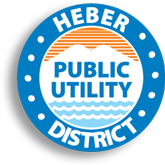Community History
The community of Heber had its origins with the construction of the Imperial Valley branch of the Southern Pacific Railroad during the early 1900's. The Imperial Land Company, working under the direction of the California Development Company, elected to honor company President A.H. Heber by naming the community after him in 1903.
The anticipated construction of the San Diego Yuma railroad, which was expected to pass through Heber, spurred local development for the next five years.
However, in 1908, Heber's initially rapid growth slowed considerably as the nearby community at El Centro gained importance as a regional center. Heber's continued existence, as well as the existence of most of Imperial County's other communities has been based on the importance of agriculture and its reliance on irrigation.
You can view and download historic documents like:
● Imperial County Ordinaces 92 & 93 filed July 6,1931
● Petition to the Imperial County for the Heber Public Utility District
About Heber Public Utility District
The Heber Public Utility District (HPUD) was formed in 1931 under the Public Utility Act of 1921. The Heber Public Utility District was given the authority to function as a legal entity with powers similar to those of a city administrative body.
Water used by the Heber Public Utility District is supplied by the Central Main Canal via the Dogwood Canal, both of which are under the jurisdiction of the Imperial Irrigation District (IID). The water is drawn from the canal, treated at our newly expanded water treatment plant. The Heber Public Utility District’s water treatment plant can treat 4 million gallons per day and pumps potable water through 24 miles of metered water lines into our customer’s homes and businesses. After the water is used by our community it is then re-treated at our sewage treatment plant, and finally clean and clear effluent is disposed of via agricultural drainage canals to the Salton Sea.
Prior to 1968, sewage treatment needs in Heber were met through the use of septic tanks. Heber first sewage treatment plant was completed in 1968 with a design capacity of 150,000 gallons per day. Today, the Heber Public Utility District operates a modern sewage treatment plant that can treat 1.2 million gallons per day.
Over time the services the Heber Public Utility District provides to our community has grown along with our population. Today, the Heber Public Utility District proudly provides water, sewer, solid waste (trash), parks and recreation, and street lighting to our community.
Location
Heber, an unincorporated community of approximately nine square-mile area located 224 miles southeast of Los Angeles, 675 miles southeast of San Francisco, 117 miles east of San Diego, 240 miles west of Phoenix, and 6 miles north of Mexicali, Baja California, Mexico.
Population
From 1990 to 2000, The Heber town site population increased from 2,566 persons to 2,988 persons, per U.S. Census Bureau. From 2000 to 2009 the calculated population increased to 6,000 persons. Today, Heber is home to 6,600 residents.
Water
Raw water used by the Heber Public Utility District is supplied by the Central Main Canal via the Dogwood Canal, both of which are under the jurisdiction of the Imperial Irrigation District IID. This water has its origin in Lake Mead behind Hoover Dam in Nevada. The water is drawn from the canal, treated, used by the community and then re-treated in the Heber Public Utility District sewage treatment plant, and finally disposed of via agricultural drainage canals to the Salton Sea.
Heber Public Utility District’s first water treatment plant was completed in 1972. The water treatment plant has undergone many upgrades and improvements to meet all health and safety potable water regulations.
Wastewater
Prior to 1968, sewage treatment needs in Heber were met through the use of septic tanks. Heber first sewage treatment plant was completed in 1968 with a design capacity of 150,000 gallons per day.
In 1981 a new sewage treatment plant was built which more than doubled the previous treatment plant operating capacity.




